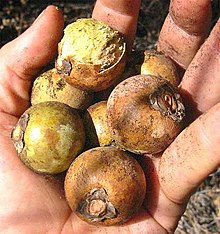Acrocomia aculeata
| Acrocomia aculeata | |
|---|---|

| |
| Scientific classification | |
| Kingdom: | Plantae |
| Clade: | Tracheophytes |
| Clade: | Angiosperms |
| Clade: | Monocots |
| Clade: | Commelinids |
| Order: | Arecales |
| Family: | Arecaceae |
| Genus: | Acrocomia |
| Species: | A. aculeata
|
| Binomial name | |
| Acrocomia aculeata | |
Acrocomia aculeata is a species of palm native to the Neotropics.
Common names
[edit]Common names include grugru palm, gloo gloo, corojo, macaúba palm, coyol palm, and macaw palm; synonyms include A. lasiospatha, A. sclerocarpa, and A. vinifera.
Description
[edit]

It grows up to 15–20 m (50–70 ft) tall, with a trunk up to 50 cm (20 in) in diameter, characterized by numerous slender, black, viciously sharp 10 cm (4 in) long spines jutting out from the trunk. This palm tree usually grows up to 10 - 15 metres tall.[3] The leaves are pinnate, 3–4 m (10–13 ft) long, with numerous slender, 50–100 cm (1 ft 8 in – 3 ft 3 in) long leaflets. Petioles of the leaves are also covered with spines. The flowers are small, produced on a large branched inflorescence 1.5 m (5 ft) long. The fruit is a yellowish-green drupe 2.5–5 cm (1–2 in) in diameter. The inner fruit shell, also called endocarp, is very tough to break and contains usually one single, dark brown, nut-like seed 1–2 cm (1⁄2–3⁄4 in) in diameter. The inside of the seed, also called endosperm, is a dry white filling that has a vaguely sweet taste like coconut when eaten. The fruit turns yellow when ripe and has a hard outer shell. The pulp is slightly sweet and is extremely slimy and sticky.
Distribution and habitat
[edit]The species is found from southern Mexico and the Caribbean to Brazil, where it inhabits diverse environments such as the Cerrado savanna [4] and the Mata Atlântica rainforest. It also extends into Paraguay and northern Argentina, thriving in environments ranging from grasslands to subtropical forests.
Ecology
[edit]The tree was noted by the English naturalist Henry Walter Bates in his 1863 book The Naturalist on the River Amazons, where he wrote that
[The hyacinth macaw] flies in pairs, and feeds on the hard nuts of several palms, but especially of the Mucuja (Acrocomia lasiospatha). These nuts, which are so hard as to be difficult to break with a heavy hammer, are crushed to a pulp by the powerful beak of this macaw.
— Bates[5]
Uses
[edit]
The plants inhabit a wide variety of climates and situations; in Paraguay, for example, where it is ubiquitous, it is called the coco paraguayo (Paraguayan coconut), as it is much less common in the rest of the world. It has been suggested that grugru nuts, which come in mass numbers from each tree, can be used in the manufacture of biodiesel. The grugru nut, while very hard, can be sliced into thin circles to be sanded and worn as rings. The trunk of the palm can also be 'milked' to yield a fermented alcoholic beverage known as coyol wine.
References
[edit]- ^ Machuca Machuca, K.; Martínez Salas, E.; Quero, H.; Samain, M.-S. (2022). "Acrocomia aculeata". IUCN Red List of Threatened Species. 2022: e.T201622A2709063. doi:10.2305/IUCN.UK.2022-1.RLTS.T201622A2709063.en. Retrieved 23 November 2022.
- ^ Martius, Historia Naturalis Palmarum 2:66. 1824
- ^ "Acrocomia aculeata - Useful Tropical Plants". tropical.theferns.info. Retrieved 2024-09-24.
- ^ "Acrocomia aculeata". Horto Botânico (in Portuguese).
- ^ Bates, H. W. (1863). The Naturalist on the River Amazons (1st (long) ed.). London: James Murray. pp. 79–80.
- Germplasm Resources Information Network: Acrocomia
- PACSOA: Acrocomia aculeata
- Project for Neotropical Fruits: Acrocomia aculeata
- Leuphana Universität, Lüneburg (2013) Macauba - Sustainable Palm Oil

